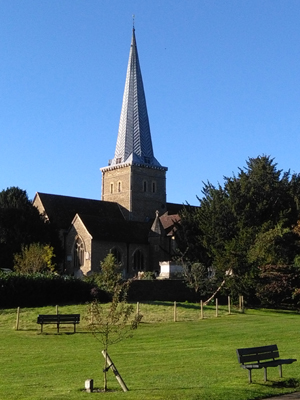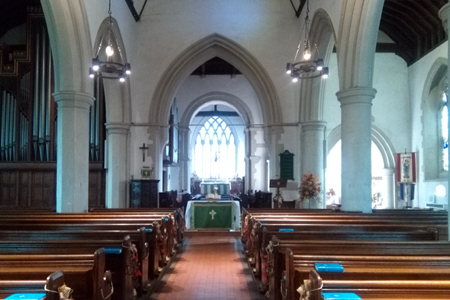| |
 |
 |
 |
| Comment on this report, or find other reports. |
 |
| Our Mystery Worshippers are volunteers who warm church pews for us around the world. If you'd like to become a Mystery Worshipper, start here. |
 |
| Find out how to reproduce this report in your church magazine or website. |
|
|
| 3078: St Peter & St Paul, Godalming, England |
 |
 |
 |
Mystery Worshipper: Ken T. Poste.
The church: St Peter & St Paul, Godalming, Surrey, England.
Denomination: Church of England, Diocese of Guildford.
The building: The church here dates back to the ninth century, though it has been added to and changed around a number of times since. The church's spire is visible from the north, but is rather obscured by other buildings if you are in the town. The oldest part is a font that is thought to be the oldest in England. The main body of the church is quite spacious, though the pillars give quite a few of the seating positions a restricted view. The "functional" altar is between the choir stalls and front pews, though behind them, the church narrows in a passageway leading to the high altar, where the eucharist was ministered.
The church: They are currently in an interregnum and hope to have a new rector by the start of the year, Easter at the latest. They have a strong musical heritage, with regular organ recitals; the choir also recently performed at Guildford Cathedral. The church runs a children's group called Octots, a food bank, and also had midweek home groups.
The neighbourhood: Godalming regularly gets listed as one of the nicest places to live in England. Situated a few miles to the south of Guildford, on the Greensand Ridge, a mixed greens and sandstone escarpment in southeast England, it is a particularly leafy town populated by small shops on narrow streets. At the back of the church is a small park that runs along the banks of the River Wey and is populated by ducks that have no objection to coming up to you if you happen to be sat on a bench eating your lunch. An unusual claim to fame is that in 1881 the town was the first in the world to have a public electricity supply.
The cast: The service was led by a guest minister, the Revd Andy Spencer, who also preached. The Old Testament reading was given by Susan Lochner and prayers were led by Tony Gordon-Smith. The person who gave the New Testament reading wasn't named.
The date & time: Twentieth Sunday After Trinity, 9 October 2016, 10.00am.
What was the name of the service?
Choral Eucharist.
How full was the building?
There were about 100 people, with the choir constituting about a quarter of that. The church could comfortably accommodate three times that number. It was noticeable that almost everyone sat toward the back of the church. The 60-80 age group seemed much more well populated among the congregation than my 20-40 age group.
Did anyone welcome you personally?
I was given a hymn book with leaflets tucked inside. These were offered at arm's length with no handshake. Nobody spoke to me before the service began.
Was your pew comfortable?
We had long, hard, solid pews that one would be extremely generous to refer to as comfortable. Instead, I shall opt for describing them as tolerable.
How would you describe the pre-service
atmosphere?
Having arrived a little early, I sat in the park behind the church where one could clearly hear the pealing of the bells, which began about 20 minutes before the service. As soon as I got within 10 feet of the walls of the church, the rest of the building muffled the sound, so it was somewhat quieter inside. People were fairly chatty, with the reputation of the town as fairly posh being born out in the cut glass accents.
What were the exact opening words of the
service?
"Good morning, everyone, and welcome to our Choral Eucharist."
What books did the congregation use during the
service?
We used a green hymnbook called New English Hymnal. Into this was tucked a weekly newsletter and a rather tatty looking (or well-used, if you prefer) order of service adapted from Common Worship. Readings were from The Holy Bible, New International Version, a single copy of which was placed at the end of each pew.
What musical instruments were played?
There was just an organ. Nothing else. The organ was built by Hill, Norman & Beard in 1961, with further improvement made to it more recently by FH Browne of Canterbury.
Did anything distract you?
There were a number of odd sounds during the hymns. At one point, something outside gave a deep rumbling like a low flying aircraft – only the church isn't on any flight path. Several congregants looked around with puzzled expressions on their faces. At a few seemingly random points, the organ increased in volume and took on what I could only describe as a "nasal tone" to it, which had the effect of drowning out the words that were being sung. Whether or not this was the intended effect, I could not tell. Oh, and one of the ushers bore a striking resemblance to children's author Roald Dahl.

Was the worship stiff-upper-lip, happy clappy, or
what?
It was slightly high church. This could be seen by the use of liturgy, vestments, and the occasional donging of a bell during the institution of the eucharist, though they stopped short of swinging incense or chanting in Latin.
The priest wore a black cassock, on top of which were a white surplice and a green stole.
The choir had a good mix to it, and for a local choir they were very good. All members wore burgundy robes; the women had star-shaped collars, while the men wore surplices over their robes.
Exactly how long was the sermon?
10 minutes.
On a scale of 1-10, how good was the preacher?
7 – The Revd Andy occupied the pulpit with near stationary stance, holding the pulpit with arms slightly apart as he leaned forward. He didn't have the clearest of enunciations, but he made himself understood.
In a nutshell, what was the sermon
about?
Based on Jeremiah 29:1,4-7 (settle down and marry) and Luke 17:11-19 (Jesus heals the lepers), the theme was "Faith: Tried and Tested." We were encouraged to keep the faith but also to be a part of the country. Daniel is a prime example of one who had the faith to live as an exile. The lepers in the gospel were effectively the walking dead; their illness meant their lives were over for all intents and purposes. So their healing prophesied resurrection. Faith in God in not a panacea for our troubles, as God meets us where we are. Go and tell everyone that God is with us.
Which part of the service was like being in
heaven?
There was a strong feeling of inclusion in the church, particularly for the disabled. By the front door, next to a wheelchair ramp, there was a sign saying that all were welcome. During the eucharist, some of the servers took the elements out into the congregation to those who were unable to walk up and kneel by the altar rail.
I also loved the gospel reading. The reader had good intonation, bringing the text and the dialogue to life. Too often the Bible is read in monotone, but this was a breath of fresh air.
And which part was like being in... er... the other place?
The only thing that irked me was that the sense of inclusion stopped when it came to the children. One of them was invited to light a candle at the start of the service, but then the children were almost immediately sent out and didn't come back until the eucharist. I can understand that they might not be able to sit through a whole service, but it felt like they were being cut out from being able to participate in most of the worship along with the rest of the church.
What happened when you hung around after the service looking lost?
The person who had been sat next to me came over to ask if I was visiting. I gathered that they tend not to have a lot of visitors, so I somewhat stood out. While there was a note in the service sheet that mentioned teas and coffees were available, nothing was said, so I had to follow someone into a back room to find where they were being served.
How would you describe the after-service
coffee?
Bland but inoffensive. I like a coffee to have some body to it, but it was rather weak. However, it was served in a very civilised cup with a saucer. There were a few biscuits on offer too. As I stood to queue, one person jumped ahead of me, much to my chagrin. But strangest of all, I was asked if I would come and listen to someone. That someone was a woman who was in the midst of denouncing all evangelicals and expressing fear that that with no rector, there may be a delay to re-hanging the bells. She went on to say that if a woman were called as the new rector, it would prompt her to leave the church, as she doesn't like women and thinks they shouldn't be priests. I smiled politely and said "Oh right" several times, masking my disagreement. She also protested that she didnít know all the hymns. I chimed in with the suggestion that one can't go far wrong with a good dose of Charles Wesley.
How would you feel about making this church your regular (where 10 = ecstatic, 0 = terminal)?
6 – It would have been higher had it not been for the slightly alarming chat over coffee. Overall, it is better suited those of a more conservative bent than I. But it's not a bad advert for rural Anglicanism.
Did the service make you feel glad to be a
Christian?
Up until the after-service sermonette during coffee, yes. Now I'm not so sure.
What one thing will you remember about all this in seven days' time?
"A church open to all" – unless you are an evangelical or a woman priest. |
|
|
 |
 |
 |
| We rely on voluntary donations to stay online. If you're a regular visitor to Ship of Fools, please consider supporting us. |
 |
 |
 |
| The Mystery Pilgrim |
 |
| One of our most seasoned reporters makes the Camino pilgrimage to Santiago de Compostela in Spain. Read here. |
 |
 |
 |
| London churches |
 |
| Read reports from 70 London churches, visited by a small army of Mystery Worshippers on one single Sunday. Read here. |
| |
|
|
|
|


